Strategic Analysis of the Tourism Industry: SWOT, Porter's Five Forces
VerifiedAdded on 2021/05/31
|8
|2095
|419
Essay
AI Summary
This essay explores the application of strategic management tools in the tourism industry, focusing on SWOT analysis, Porter's Five Forces, and PESTEL analysis. SWOT analysis identifies internal strengths and weaknesses, as well as external opportunities and threats. Porter's Five Forces examines competitive rivalry, buyer and supplier power, the threat of new entrants, and substitute products. PESTEL analysis assesses political, economic, social, technological, environmental, and legal factors affecting the industry. The analysis provides insights into how these tools can be used to develop effective strategies for tourism organizations to achieve their goals and objectives. Desklib provides solved assignments for students.

Introduction:
The strategic tools in an organization play a vital role in defining the strategic planning that
understands the direction, strategy, and decision making regarding the allocation of the resources
for practicing the strategies. Strategic management tools in organizations result in effectively
dealing with an extensive collection of factors that are affecting the business. Such strategic
management tools help in continuously monitoring the external and internal events for making the
timely changes for the growth of the organisation. Therefore, such strategic management tools
develop an encompassing approach for implementing, evaluating and formulating the decisions of
the management which inturns results in organisations in achieving the goals and objectives.
There are many different analysis techniques utilized in an organisation for the strategic planning
such as the PEST analysis, SWOT analysis, Porters five forces, RBV, PROFIT, and CIA.
SWOT analysis:
There are different management strategic tools and models that are employed for analysing the
organisational decisions. Swot analysis is one of the simple but widely used tools that help to
understand the strengths, weaknesses, opportunities, and threats that are involved in the business.
The analysis helps in defining the project objectives and identifying the external and internal
factors those are significant in achieving the objectives (Tassabehji and Isherwood, 2014).
Strengths and Weaknesses are generally internal to the organisation, whereas the opportunities
and threats are generally external. Such analysis s often plotted on the straightforward matrix of
2x2.SWOT analysis in the tourism industry is to identify the internal and the external factors of
the industry that is in the favour or against the objectives of the industry (Tassabehji and
Isherwood, 2014).
Strength Opportunities’
The strategic tools in an organization play a vital role in defining the strategic planning that
understands the direction, strategy, and decision making regarding the allocation of the resources
for practicing the strategies. Strategic management tools in organizations result in effectively
dealing with an extensive collection of factors that are affecting the business. Such strategic
management tools help in continuously monitoring the external and internal events for making the
timely changes for the growth of the organisation. Therefore, such strategic management tools
develop an encompassing approach for implementing, evaluating and formulating the decisions of
the management which inturns results in organisations in achieving the goals and objectives.
There are many different analysis techniques utilized in an organisation for the strategic planning
such as the PEST analysis, SWOT analysis, Porters five forces, RBV, PROFIT, and CIA.
SWOT analysis:
There are different management strategic tools and models that are employed for analysing the
organisational decisions. Swot analysis is one of the simple but widely used tools that help to
understand the strengths, weaknesses, opportunities, and threats that are involved in the business.
The analysis helps in defining the project objectives and identifying the external and internal
factors those are significant in achieving the objectives (Tassabehji and Isherwood, 2014).
Strengths and Weaknesses are generally internal to the organisation, whereas the opportunities
and threats are generally external. Such analysis s often plotted on the straightforward matrix of
2x2.SWOT analysis in the tourism industry is to identify the internal and the external factors of
the industry that is in the favour or against the objectives of the industry (Tassabehji and
Isherwood, 2014).
Strength Opportunities’
Paraphrase This Document
Need a fresh take? Get an instant paraphrase of this document with our AI Paraphraser
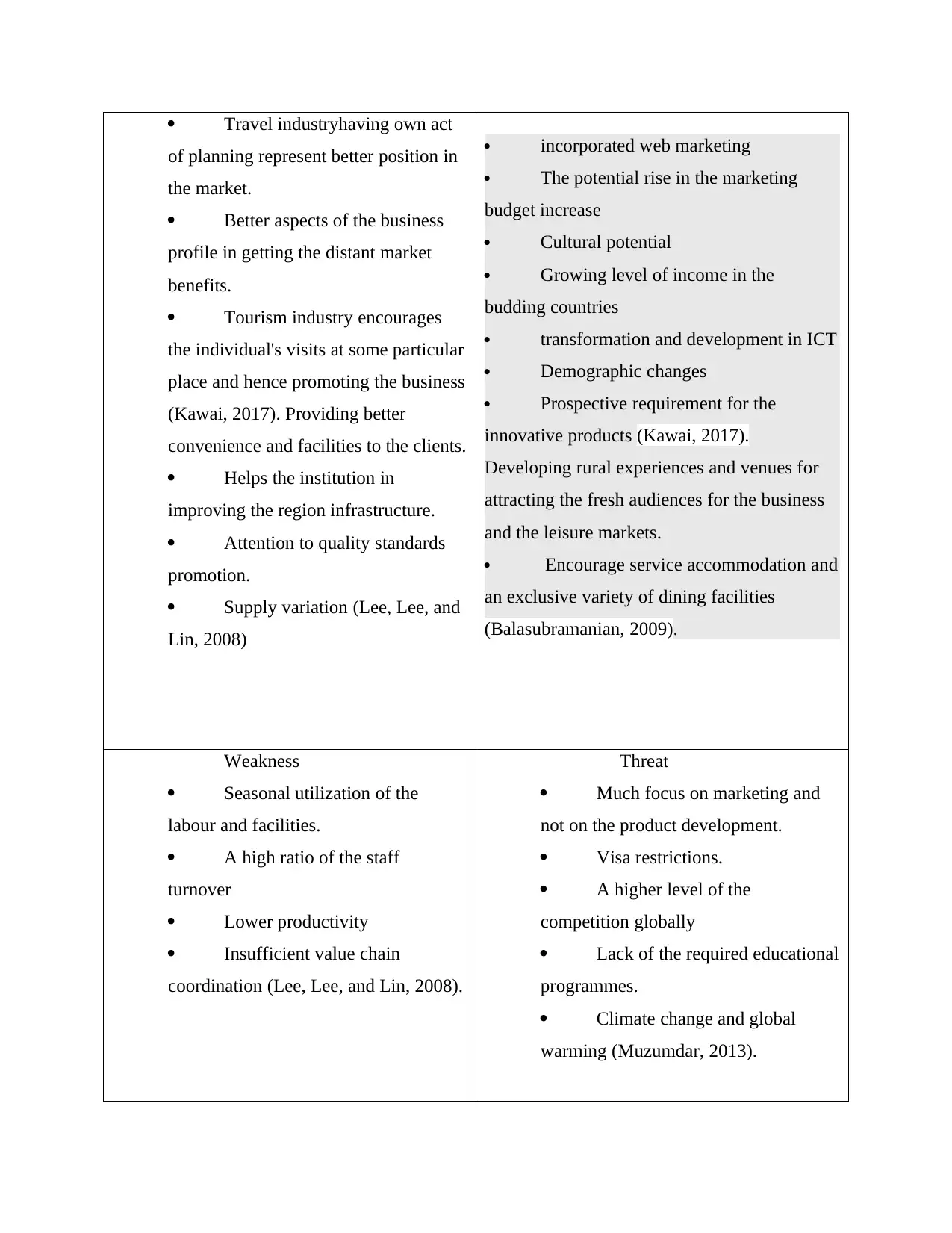
Travel industryhaving own act
of planning represent better position in
the market.
Better aspects of the business
profile in getting the distant market
benefits.
Tourism industry encourages
the individual's visits at some particular
place and hence promoting the business
(Kawai, 2017). Providing better
convenience and facilities to the clients.
Helps the institution in
improving the region infrastructure.
Attention to quality standards
promotion.
Supply variation (Lee, Lee, and
Lin, 2008)
incorporated web marketing
The potential rise in the marketing
budget increase
Cultural potential
Growing level of income in the
budding countries
transformation and development in ICT
Demographic changes
Prospective requirement for the
innovative products (Kawai, 2017).
Developing rural experiences and venues for
attracting the fresh audiences for the business
and the leisure markets.
Encourage service accommodation and
an exclusive variety of dining facilities
(Balasubramanian, 2009).
Weakness
Seasonal utilization of the
labour and facilities.
A high ratio of the staff
turnover
Lower productivity
Insufficient value chain
coordination (Lee, Lee, and Lin, 2008).
Threat
Much focus on marketing and
not on the product development.
Visa restrictions.
A higher level of the
competition globally
Lack of the required educational
programmes.
Climate change and global
warming (Muzumdar, 2013).
of planning represent better position in
the market.
Better aspects of the business
profile in getting the distant market
benefits.
Tourism industry encourages
the individual's visits at some particular
place and hence promoting the business
(Kawai, 2017). Providing better
convenience and facilities to the clients.
Helps the institution in
improving the region infrastructure.
Attention to quality standards
promotion.
Supply variation (Lee, Lee, and
Lin, 2008)
incorporated web marketing
The potential rise in the marketing
budget increase
Cultural potential
Growing level of income in the
budding countries
transformation and development in ICT
Demographic changes
Prospective requirement for the
innovative products (Kawai, 2017).
Developing rural experiences and venues for
attracting the fresh audiences for the business
and the leisure markets.
Encourage service accommodation and
an exclusive variety of dining facilities
(Balasubramanian, 2009).
Weakness
Seasonal utilization of the
labour and facilities.
A high ratio of the staff
turnover
Lower productivity
Insufficient value chain
coordination (Lee, Lee, and Lin, 2008).
Threat
Much focus on marketing and
not on the product development.
Visa restrictions.
A higher level of the
competition globally
Lack of the required educational
programmes.
Climate change and global
warming (Muzumdar, 2013).
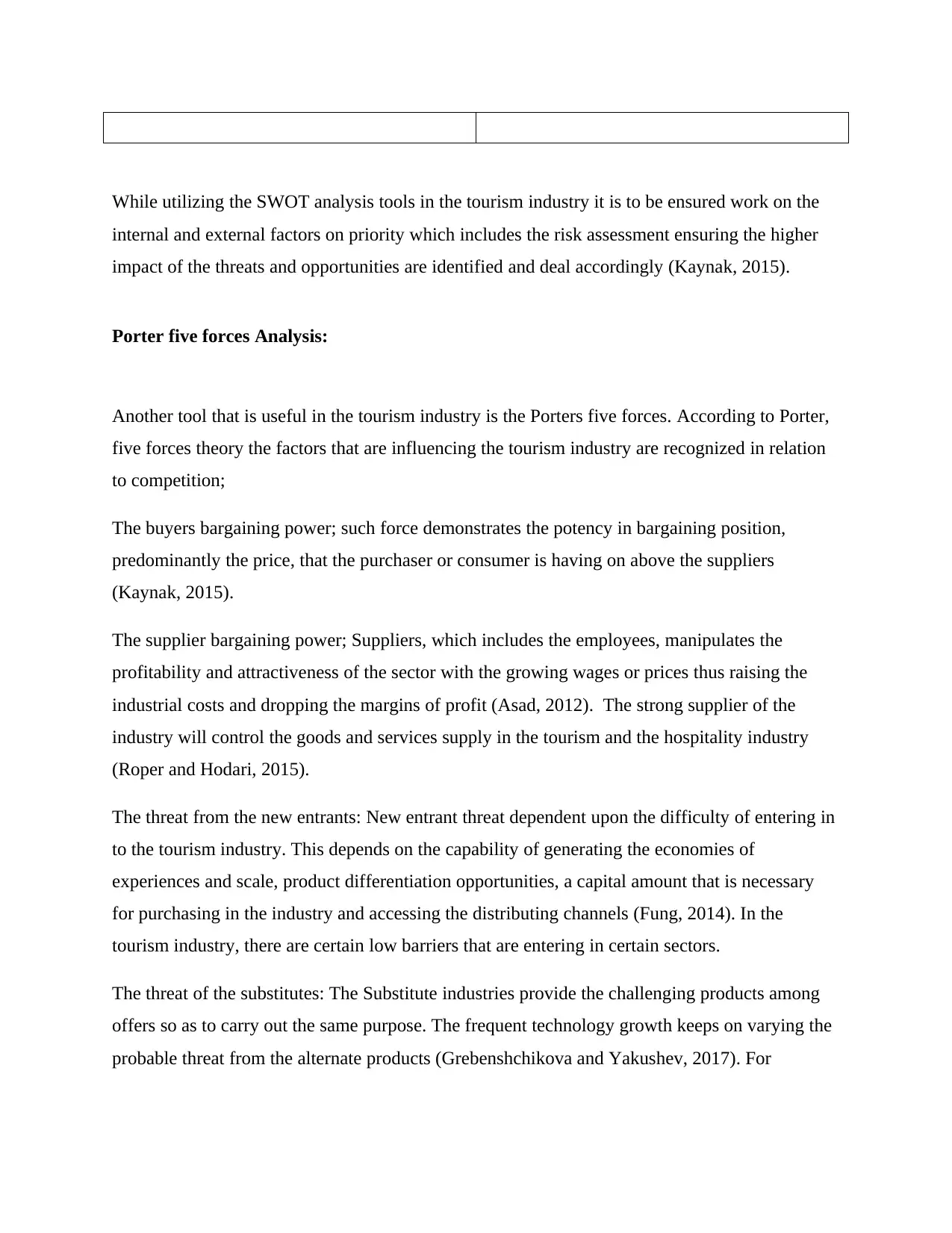
While utilizing the SWOT analysis tools in the tourism industry it is to be ensured work on the
internal and external factors on priority which includes the risk assessment ensuring the higher
impact of the threats and opportunities are identified and deal accordingly (Kaynak, 2015).
Porter five forces Analysis:
Another tool that is useful in the tourism industry is the Porters five forces. According to Porter,
five forces theory the factors that are influencing the tourism industry are recognized in relation
to competition;
The buyers bargaining power; such force demonstrates the potency in bargaining position,
predominantly the price, that the purchaser or consumer is having on above the suppliers
(Kaynak, 2015).
The supplier bargaining power; Suppliers, which includes the employees, manipulates the
profitability and attractiveness of the sector with the growing wages or prices thus raising the
industrial costs and dropping the margins of profit (Asad, 2012). The strong supplier of the
industry will control the goods and services supply in the tourism and the hospitality industry
(Roper and Hodari, 2015).
The threat from the new entrants: New entrant threat dependent upon the difficulty of entering in
to the tourism industry. This depends on the capability of generating the economies of
experiences and scale, product differentiation opportunities, a capital amount that is necessary
for purchasing in the industry and accessing the distributing channels (Fung, 2014). In the
tourism industry, there are certain low barriers that are entering in certain sectors.
The threat of the substitutes: The Substitute industries provide the challenging products among
offers so as to carry out the same purpose. The frequent technology growth keeps on varying the
probable threat from the alternate products (Grebenshchikova and Yakushev, 2017). For
internal and external factors on priority which includes the risk assessment ensuring the higher
impact of the threats and opportunities are identified and deal accordingly (Kaynak, 2015).
Porter five forces Analysis:
Another tool that is useful in the tourism industry is the Porters five forces. According to Porter,
five forces theory the factors that are influencing the tourism industry are recognized in relation
to competition;
The buyers bargaining power; such force demonstrates the potency in bargaining position,
predominantly the price, that the purchaser or consumer is having on above the suppliers
(Kaynak, 2015).
The supplier bargaining power; Suppliers, which includes the employees, manipulates the
profitability and attractiveness of the sector with the growing wages or prices thus raising the
industrial costs and dropping the margins of profit (Asad, 2012). The strong supplier of the
industry will control the goods and services supply in the tourism and the hospitality industry
(Roper and Hodari, 2015).
The threat from the new entrants: New entrant threat dependent upon the difficulty of entering in
to the tourism industry. This depends on the capability of generating the economies of
experiences and scale, product differentiation opportunities, a capital amount that is necessary
for purchasing in the industry and accessing the distributing channels (Fung, 2014). In the
tourism industry, there are certain low barriers that are entering in certain sectors.
The threat of the substitutes: The Substitute industries provide the challenging products among
offers so as to carry out the same purpose. The frequent technology growth keeps on varying the
probable threat from the alternate products (Grebenshchikova and Yakushev, 2017). For
⊘ This is a preview!⊘
Do you want full access?
Subscribe today to unlock all pages.

Trusted by 1+ million students worldwide

example, the speedy expansion of video-conferencing among the hotel and tourism meetings acts
as a substitute product (Olsen and Zhao, 2004).
Such combination of the factors helps in determine the survival and the economic value. The
Porters five forces analysis in the industry provides opportunities for the industry to establish and
communicates the distinctive or the unique positions for the businesses and in the case of the
tourism industry this is critical (Pasanen, 2011).
The Porter's five forces model supports in understanding the new ideas and business of the
organisation in context of the buyers bargaining powers. Analysis of the five forces supports a
great understanding towards the factors and driving the business for differentiating themselves
(Önören, Arar and Yurdakul, 2017).
PESTEL analysis:
PEST analysis results in analysing the external macro-environment factors which are responsible
for the existence of the organisation. Such tool is used for understanding the political, economic,
socio-cultural and technological environment of the industry (Kampanje, 2012). Such tool is
used for evaluating the growth or downfall of the market and among this the potential, position
and business direction (User, 2018). Discussed are the PEST analysis tool in the industrial
environment and its effect on the tourism industry.
Political:
Political factors internationally have a straight and profound impact on the tourism industry.
However, it is regimes of the changing government nationally; the effect on the industry is
forever direct. Political steadiness benefits the tourism industry in a great way. Tourism grows in
an environment that is free of turmoil and cannot flourishes in an environment of terror or
conflict (Yüksel, 2012).
Economy
as a substitute product (Olsen and Zhao, 2004).
Such combination of the factors helps in determine the survival and the economic value. The
Porters five forces analysis in the industry provides opportunities for the industry to establish and
communicates the distinctive or the unique positions for the businesses and in the case of the
tourism industry this is critical (Pasanen, 2011).
The Porter's five forces model supports in understanding the new ideas and business of the
organisation in context of the buyers bargaining powers. Analysis of the five forces supports a
great understanding towards the factors and driving the business for differentiating themselves
(Önören, Arar and Yurdakul, 2017).
PESTEL analysis:
PEST analysis results in analysing the external macro-environment factors which are responsible
for the existence of the organisation. Such tool is used for understanding the political, economic,
socio-cultural and technological environment of the industry (Kampanje, 2012). Such tool is
used for evaluating the growth or downfall of the market and among this the potential, position
and business direction (User, 2018). Discussed are the PEST analysis tool in the industrial
environment and its effect on the tourism industry.
Political:
Political factors internationally have a straight and profound impact on the tourism industry.
However, it is regimes of the changing government nationally; the effect on the industry is
forever direct. Political steadiness benefits the tourism industry in a great way. Tourism grows in
an environment that is free of turmoil and cannot flourishes in an environment of terror or
conflict (Yüksel, 2012).
Economy
Paraphrase This Document
Need a fresh take? Get an instant paraphrase of this document with our AI Paraphraser
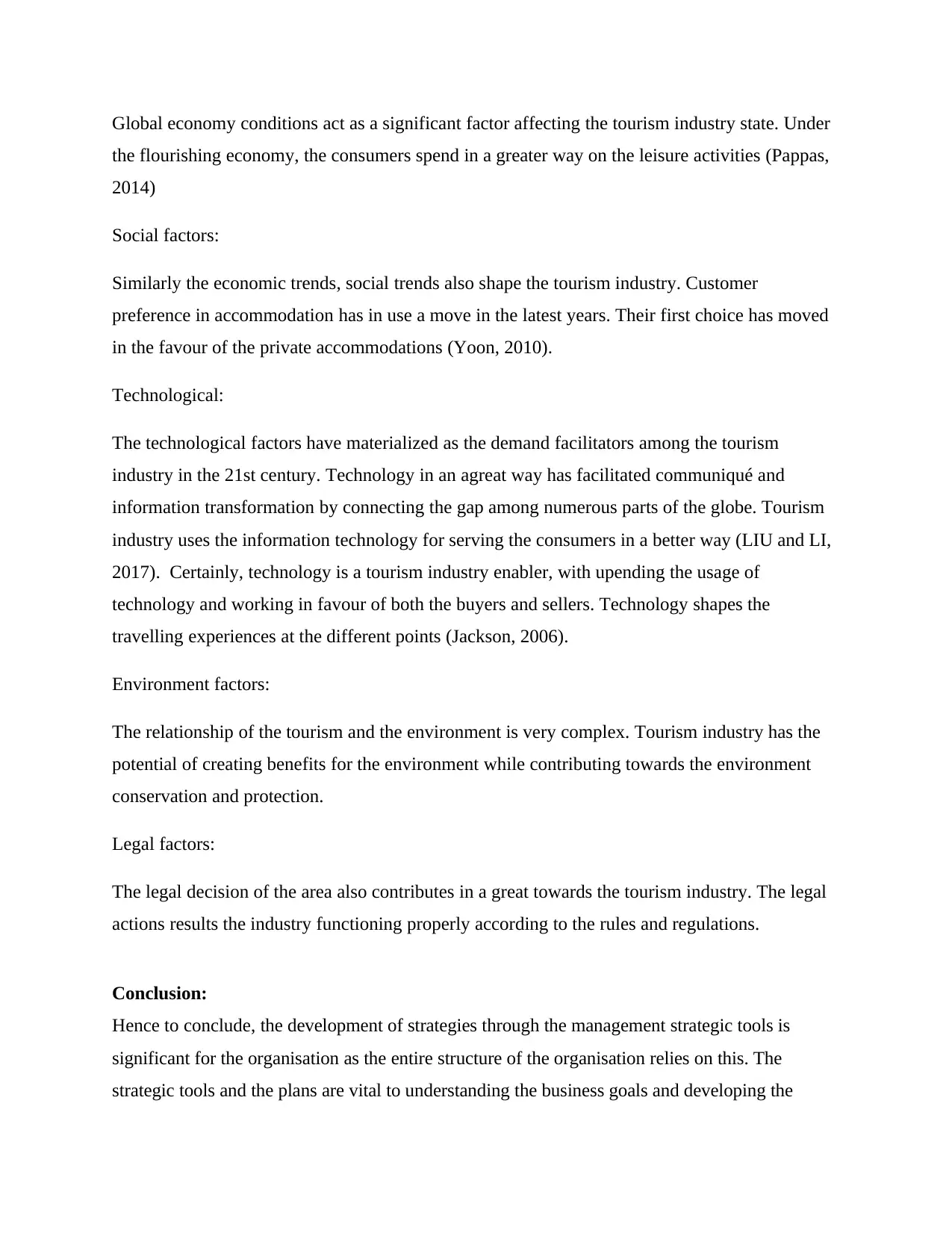
Global economy conditions act as a significant factor affecting the tourism industry state. Under
the flourishing economy, the consumers spend in a greater way on the leisure activities (Pappas,
2014)
Social factors:
Similarly the economic trends, social trends also shape the tourism industry. Customer
preference in accommodation has in use a move in the latest years. Their first choice has moved
in the favour of the private accommodations (Yoon, 2010).
Technological:
The technological factors have materialized as the demand facilitators among the tourism
industry in the 21st century. Technology in an agreat way has facilitated communiqué and
information transformation by connecting the gap among numerous parts of the globe. Tourism
industry uses the information technology for serving the consumers in a better way (LIU and LI,
2017). Certainly, technology is a tourism industry enabler, with upending the usage of
technology and working in favour of both the buyers and sellers. Technology shapes the
travelling experiences at the different points (Jackson, 2006).
Environment factors:
The relationship of the tourism and the environment is very complex. Tourism industry has the
potential of creating benefits for the environment while contributing towards the environment
conservation and protection.
Legal factors:
The legal decision of the area also contributes in a great towards the tourism industry. The legal
actions results the industry functioning properly according to the rules and regulations.
Conclusion:
Hence to conclude, the development of strategies through the management strategic tools is
significant for the organisation as the entire structure of the organisation relies on this. The
strategic tools and the plans are vital to understanding the business goals and developing the
the flourishing economy, the consumers spend in a greater way on the leisure activities (Pappas,
2014)
Social factors:
Similarly the economic trends, social trends also shape the tourism industry. Customer
preference in accommodation has in use a move in the latest years. Their first choice has moved
in the favour of the private accommodations (Yoon, 2010).
Technological:
The technological factors have materialized as the demand facilitators among the tourism
industry in the 21st century. Technology in an agreat way has facilitated communiqué and
information transformation by connecting the gap among numerous parts of the globe. Tourism
industry uses the information technology for serving the consumers in a better way (LIU and LI,
2017). Certainly, technology is a tourism industry enabler, with upending the usage of
technology and working in favour of both the buyers and sellers. Technology shapes the
travelling experiences at the different points (Jackson, 2006).
Environment factors:
The relationship of the tourism and the environment is very complex. Tourism industry has the
potential of creating benefits for the environment while contributing towards the environment
conservation and protection.
Legal factors:
The legal decision of the area also contributes in a great towards the tourism industry. The legal
actions results the industry functioning properly according to the rules and regulations.
Conclusion:
Hence to conclude, the development of strategies through the management strategic tools is
significant for the organisation as the entire structure of the organisation relies on this. The
strategic tools and the plans are vital to understanding the business goals and developing the

activities to achieve such goals. The strategic tools are utilized by the marketing participants for
analysing the decisions.
analysing the decisions.
⊘ This is a preview!⊘
Do you want full access?
Subscribe today to unlock all pages.

Trusted by 1+ million students worldwide
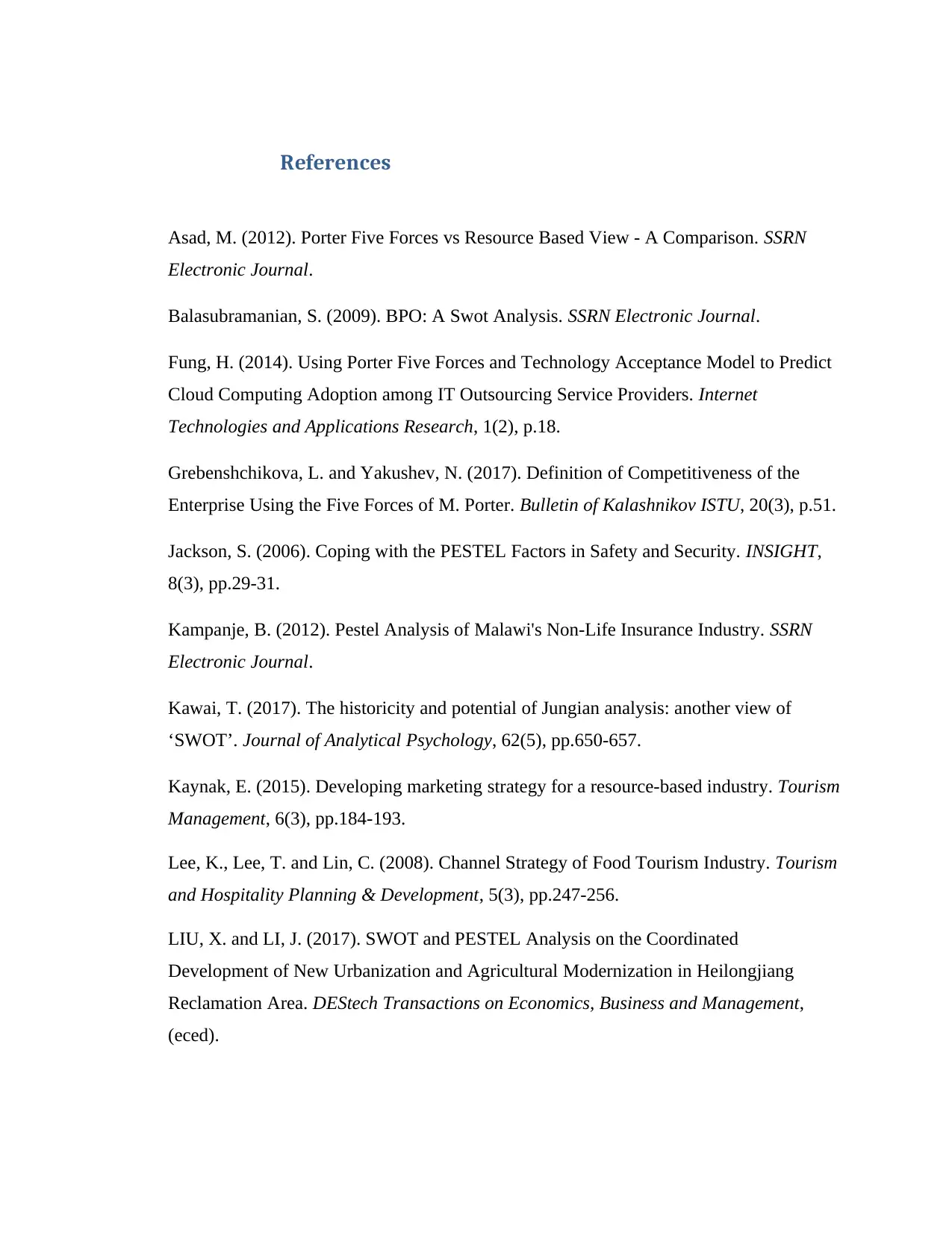
References
Asad, M. (2012). Porter Five Forces vs Resource Based View - A Comparison. SSRN
Electronic Journal.
Balasubramanian, S. (2009). BPO: A Swot Analysis. SSRN Electronic Journal.
Fung, H. (2014). Using Porter Five Forces and Technology Acceptance Model to Predict
Cloud Computing Adoption among IT Outsourcing Service Providers. Internet
Technologies and Applications Research, 1(2), p.18.
Grebenshchikova, L. and Yakushev, N. (2017). Definition of Competitiveness of the
Enterprise Using the Five Forces of M. Porter. Bulletin of Kalashnikov ISTU, 20(3), p.51.
Jackson, S. (2006). Coping with the PESTEL Factors in Safety and Security. INSIGHT,
8(3), pp.29-31.
Kampanje, B. (2012). Pestel Analysis of Malawi's Non-Life Insurance Industry. SSRN
Electronic Journal.
Kawai, T. (2017). The historicity and potential of Jungian analysis: another view of
‘SWOT’. Journal of Analytical Psychology, 62(5), pp.650-657.
Kaynak, E. (2015). Developing marketing strategy for a resource-based industry. Tourism
Management, 6(3), pp.184-193.
Lee, K., Lee, T. and Lin, C. (2008). Channel Strategy of Food Tourism Industry. Tourism
and Hospitality Planning & Development, 5(3), pp.247-256.
LIU, X. and LI, J. (2017). SWOT and PESTEL Analysis on the Coordinated
Development of New Urbanization and Agricultural Modernization in Heilongjiang
Reclamation Area. DEStech Transactions on Economics, Business and Management,
(eced).
Asad, M. (2012). Porter Five Forces vs Resource Based View - A Comparison. SSRN
Electronic Journal.
Balasubramanian, S. (2009). BPO: A Swot Analysis. SSRN Electronic Journal.
Fung, H. (2014). Using Porter Five Forces and Technology Acceptance Model to Predict
Cloud Computing Adoption among IT Outsourcing Service Providers. Internet
Technologies and Applications Research, 1(2), p.18.
Grebenshchikova, L. and Yakushev, N. (2017). Definition of Competitiveness of the
Enterprise Using the Five Forces of M. Porter. Bulletin of Kalashnikov ISTU, 20(3), p.51.
Jackson, S. (2006). Coping with the PESTEL Factors in Safety and Security. INSIGHT,
8(3), pp.29-31.
Kampanje, B. (2012). Pestel Analysis of Malawi's Non-Life Insurance Industry. SSRN
Electronic Journal.
Kawai, T. (2017). The historicity and potential of Jungian analysis: another view of
‘SWOT’. Journal of Analytical Psychology, 62(5), pp.650-657.
Kaynak, E. (2015). Developing marketing strategy for a resource-based industry. Tourism
Management, 6(3), pp.184-193.
Lee, K., Lee, T. and Lin, C. (2008). Channel Strategy of Food Tourism Industry. Tourism
and Hospitality Planning & Development, 5(3), pp.247-256.
LIU, X. and LI, J. (2017). SWOT and PESTEL Analysis on the Coordinated
Development of New Urbanization and Agricultural Modernization in Heilongjiang
Reclamation Area. DEStech Transactions on Economics, Business and Management,
(eced).
Paraphrase This Document
Need a fresh take? Get an instant paraphrase of this document with our AI Paraphraser
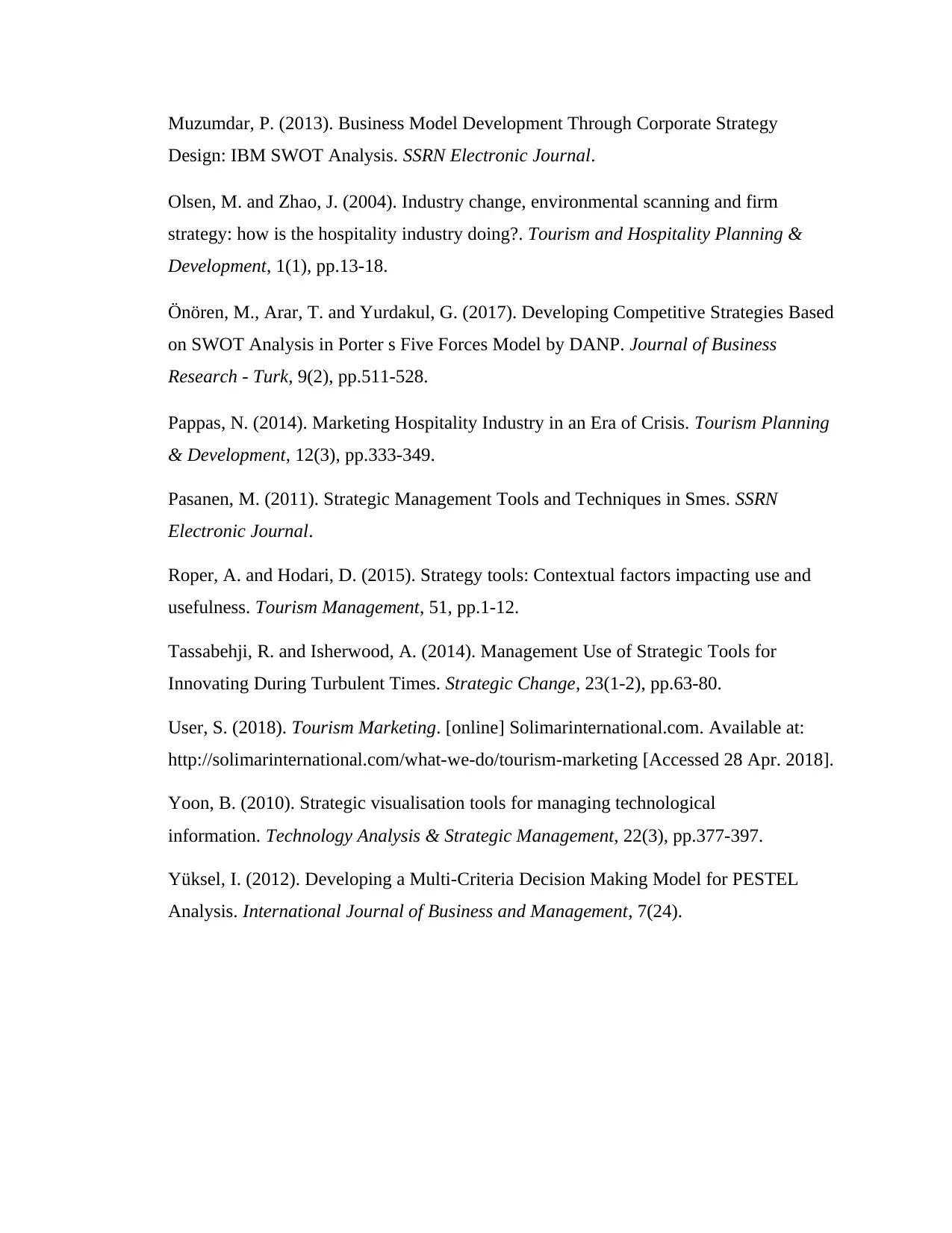
Muzumdar, P. (2013). Business Model Development Through Corporate Strategy
Design: IBM SWOT Analysis. SSRN Electronic Journal.
Olsen, M. and Zhao, J. (2004). Industry change, environmental scanning and firm
strategy: how is the hospitality industry doing?. Tourism and Hospitality Planning &
Development, 1(1), pp.13-18.
Önören, M., Arar, T. and Yurdakul, G. (2017). Developing Competitive Strategies Based
on SWOT Analysis in Porter s Five Forces Model by DANP. Journal of Business
Research - Turk, 9(2), pp.511-528.
Pappas, N. (2014). Marketing Hospitality Industry in an Era of Crisis. Tourism Planning
& Development, 12(3), pp.333-349.
Pasanen, M. (2011). Strategic Management Tools and Techniques in Smes. SSRN
Electronic Journal.
Roper, A. and Hodari, D. (2015). Strategy tools: Contextual factors impacting use and
usefulness. Tourism Management, 51, pp.1-12.
Tassabehji, R. and Isherwood, A. (2014). Management Use of Strategic Tools for
Innovating During Turbulent Times. Strategic Change, 23(1-2), pp.63-80.
User, S. (2018). Tourism Marketing. [online] Solimarinternational.com. Available at:
http://solimarinternational.com/what-we-do/tourism-marketing [Accessed 28 Apr. 2018].
Yoon, B. (2010). Strategic visualisation tools for managing technological
information. Technology Analysis & Strategic Management, 22(3), pp.377-397.
Yüksel, I. (2012). Developing a Multi-Criteria Decision Making Model for PESTEL
Analysis. International Journal of Business and Management, 7(24).
Design: IBM SWOT Analysis. SSRN Electronic Journal.
Olsen, M. and Zhao, J. (2004). Industry change, environmental scanning and firm
strategy: how is the hospitality industry doing?. Tourism and Hospitality Planning &
Development, 1(1), pp.13-18.
Önören, M., Arar, T. and Yurdakul, G. (2017). Developing Competitive Strategies Based
on SWOT Analysis in Porter s Five Forces Model by DANP. Journal of Business
Research - Turk, 9(2), pp.511-528.
Pappas, N. (2014). Marketing Hospitality Industry in an Era of Crisis. Tourism Planning
& Development, 12(3), pp.333-349.
Pasanen, M. (2011). Strategic Management Tools and Techniques in Smes. SSRN
Electronic Journal.
Roper, A. and Hodari, D. (2015). Strategy tools: Contextual factors impacting use and
usefulness. Tourism Management, 51, pp.1-12.
Tassabehji, R. and Isherwood, A. (2014). Management Use of Strategic Tools for
Innovating During Turbulent Times. Strategic Change, 23(1-2), pp.63-80.
User, S. (2018). Tourism Marketing. [online] Solimarinternational.com. Available at:
http://solimarinternational.com/what-we-do/tourism-marketing [Accessed 28 Apr. 2018].
Yoon, B. (2010). Strategic visualisation tools for managing technological
information. Technology Analysis & Strategic Management, 22(3), pp.377-397.
Yüksel, I. (2012). Developing a Multi-Criteria Decision Making Model for PESTEL
Analysis. International Journal of Business and Management, 7(24).
1 out of 8
Related Documents
Your All-in-One AI-Powered Toolkit for Academic Success.
+13062052269
info@desklib.com
Available 24*7 on WhatsApp / Email
![[object Object]](/_next/static/media/star-bottom.7253800d.svg)
Unlock your academic potential
Copyright © 2020–2025 A2Z Services. All Rights Reserved. Developed and managed by ZUCOL.




